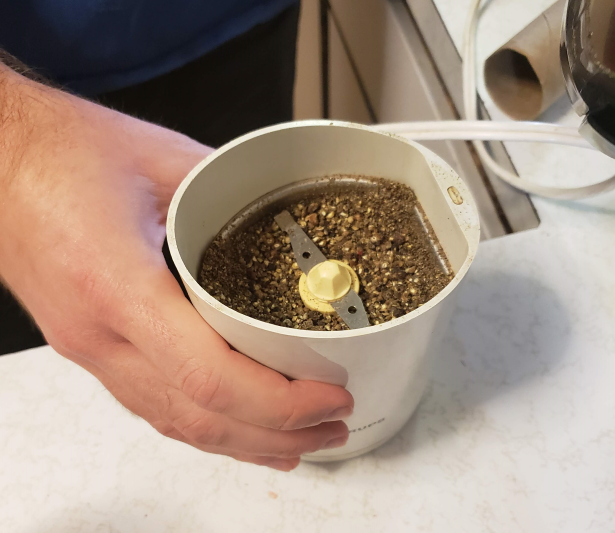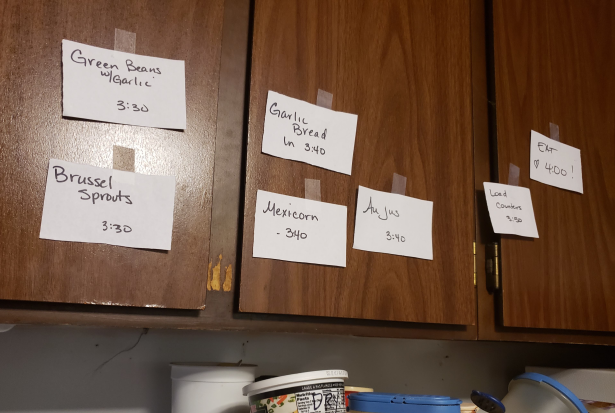KC 300 – Holiday Prime Rib

Why hello there, and welcome to Kitchen Catastrophe, where we’re waging a one-man war on culinary cowardice. I’m your Lofty Literary Lancer, Jon O’Guin, and today’s post…today’s post will be strange, I feel. I’m going to let you know straight up that it’s probably going to be heavier than usual. And the why will be pretty clear, pretty quickly. But if you want to skip all that and get to the recipe, here’s a link. For everyone else, let’s grit our teeth a little, and dig in.
Prime Time
So, if you’re unaware, “prime rib” is one of those designations that fancy places use, but might be entirely clear, so let me break it down for you. (And, as I did for the Turchetta post: vegetarians/vegans, if just seeing meat upsets you, be aware that like, 1/3rd of today’s pictures are of raw meat. (I wouldn’t normally go that far for a trigger warning, but I originally thought that ratio was going to be more like 2/3rds, so I already made the link, and I’d rather explain all that then delete the link.)) So, “prime rib” is a more marketing friendly term for what was originally called “standing rib roast”, so named because, and hear me out on this: it was a roast, from the rib, that was cooked “standing” on the rib itself. Very complicated stuff. However, there IS a bit of fiddliness here, so let’s gouge out the eyes of this meaty enigma. That was unexpectedly violent for a metaphor, but I assure you, the eyes are meat too. That didn’t help. Look, this will all make sense in a minute. Maybe.
So, the first thing to cover is there’s a lot of regional variation, slightly different prep styles, and terminology that can be confusing, but broadly speaking, a “prime rib roast” is, essentially, a collection of what could be called “rib-eye steaks” stacked next to each other, by the popular definition. Which is technically “wrong”.
Just as you can never have enough precision in your soup, you rarely can have too much technicality in your steaks.
So that’s a ‘rib-eye’, as the average steakhouse go-er would understand it. Depending on the image I found, it could be a tomahawk/cowboy cut (two different names for functionally the same cut, just with more or less of the rib exposed.), but technically speaking it’s more than that. Specifically, the issue here is that on that cut of meat are technically three to four distinct areas, which we’ll highlight here.
Graphic Design is my Passion.
(It has NEVER been clearer that I never went to that community college photoshop class I paid for to enter an acting contest)
I encourage you to laugh at me for how bad this is. It will be funnier later.
The big red circular(ish) one? THAT’S the official “rib-eye”, as in “the eye of the rib”. In medical terms, the longissimus dorsi. The purple sickle-shaped one on left, that’s the “spinalis”, more commonly called the “crown” or ‘cap’. Then the green triangle part is the “complexus” or tail. And then there’s the rib itself, which is blue, for “bone”. Depending on where you are, it might be more or less traditional for a ‘rib-eye steak’ to be:
A: just the ‘eye’. (red)
B: the eye, cap, and tail, without the rib (Purple, Red, and Green)
Or
C. All of them, still attached to the rib. (This is sometimes called a “rib steak”, or, if the bone is cleaned, again, a Tomahawk or Cowboy cut)
If you’re using definition C, then “prime rib” IS just “a bunch of rib-eyes next to each other, maybe with a thicker fat cap”. But if you’re using A or B, that definition is slightly wrong. The IMPORTANT thing is that, if you know about rib-eyes (often considered one of the best steaks), then understanding that a prime rib/rib roast is just 10 pounds of rib-eyes explains why they’re such showy centerpieces for the holiday. The meat ALONE for a prime rib is often around $8-10 per pound.
As to why we moved to “prime rib” over ‘standing rib roast”…It’s hard to say, but I think a couple elements came into play. Firstly, the REASON you roast it ‘standing’ is so that bones on the bottom help it stand out of its rendering juices, they keep it shielded from aggressive bottom heating, and it keeps the fat on the top to render down over the roast. With the proliferation of roasting racks (which handle the first problem), and more even ovens (which mitigate the second), it became less important to roast the rib ‘standing’. Secondly, as the dish became more available in restaurants, you hit a snag: technically, once you cut it into steaks, it’s not a “rib roast” anymore. So what do you call it? “Rib steak” sounds kind of boring, “standing rib roast steak” is way too many words….you need something to tell people it’s part of the rib roast, and that it’s the BEST part. Hence “prime rib”.
It is NOT because Optimus Prime’s ribs are particularly succulent. His ribs are functionally inedible. I’ve tried.
This also helps because of two related details: Firstly, the section that rib-eyes and rib roasts come from is called “the rib primal”. (It’s been years since we covered this, but basically, when you initially cut up a cow carcass, you end up with…I think in America 8ish “primals”, the initial designated chunks (Loin, brisket, ribs, chuck, round, flank, shank and short plate.) So a rib roast is MOST of a cow’s “primal rib section” or “rib primal”, so there’s already an association. And on top of that, Prime is the highest designation for beef grading in the US. A USDA Prime piece of meat is as high as our system goes. This is a LITTLE weird, because, in order, the top two are: Prime, the top ~3% of beef sold in America, goes to high-end restaurants and supermarkets. And choice…the next FIFTY PERCENT of graded beef. Under that are six other designations, including such winners as “Commercial”, “Utility”, and “Canner”. So most people only interact with the top two categories, maybe the second and third (“Select”) if they’re frugal.
So, why are we talking about it today? Because a man had ONE JOB.
A Man Needs A Name
Don’t know that that’s the best reference, but we’ll go with it. Anywho, the important thing is that Prime Rib was, for years, part of the centerpiece of Christmas dinner at my grandmother’s house.
A dinner where the DESSERTS take over an entire table.
I’ve talked about it here and there, but to re-illustrate: My mother’s family is, by most standards, quite big. My mother has 3 sisters, most of whom have 2 kids, many of whom have gotten married and had kids themselves. Our Christmas dinner in, say, 2016 had about 21 people at it, I believe. (I could be off, depending on the age of some of the youngest cousins.) So there are a LOT of mouths to feed. As such, there’s no single entrée: this dinner has ham, AND prime rib, AND sometimes a turkey. And another thing about my grandmother’s Christmas: she does not have a huge house. It’s around 1700 square feet. So for 21 people, that’s a LOT of people having to go find a spot and STAYING there, unless called for, in order to keep room for the people with tasks to do. And most people get at least one task: you might have to watch the little cousins, or cook/bring a specific dish, half the group joins the “Christmas chain gang” (The tree is centrally located, so we can’t put 20 people’s worth of presents to 19 other people under it, or there’d be a wall as high as a man’s eyes in between the dining room and the two other rooms we also have to use as dining rooms. So instead, we store most of the gifts in a sewing room down the hall, and, after dinner, form a line of people passing present after present down the hallway, to be divvied up to the respective families or recipients.)
And often, what happens is, you get a task, and that’s YOURS, now. Forever. My cousin poured the cider for me and my brothers when he was 15 or so, and he became “cider station” for damn near a decade. (Now, he’s “make cheesy mashed potatoes in a crockpot at home and bring them”, because he had children, and so he had to make sure they were eating.) And my dad’s was prime rib.
Several of you who laughed at the earlier shitty MSPaint highlight have just realized that when I said “it’ll be funnier if you laugh at me”, I meant “it’ll be funnier for ME, when you realize you were bullying a dude in a post about his deceased father.”
Most of you were just like “that’s a good-looking chunk of meat.”
In case this is your first post, or (at least) your first post where it’s come up: my father passed away in May of 2018. The pictures from today’s post are from December 2018. They represent the first time that, officially, “Prime Rib” wasn’t our dad’s responsibility, but rather Nate’s and mine. I state “officially” because we often helped out, and in 2017, our father wasn’t strong enough to make the trip to Salem so Nate had been entrusted as envoy.
And you might think that I’ve buried the lede a little here, dropping 1,000 words on beef cuts before I bring up the real reason of the post, but…what would you have of me? It is not an easy thing to speak of. I am known (or at least, was known) as a pleasantly placid man. Unshakeable. For whom anger and sorrow were alien expressions, so rare as to be off-putting. Now, as I alluded to back in November, that part of me is changed. I’ve wept twice in the last week, over the memory of my father. Once just in the space between two sentences of this paragraph, the other a few days ago, when I made a discovery during a discussion of racial justice. See, I knew, intellectually, that my father was alive when MLK died. That when (and allow me a brief pop-up onto the soap-box, so we can provide some of the view) people talk about segregation being an issue of our grandfathers, or great-grandfathers, for me at least, they lied: I am ONE generation removed from the assassination of MLK, and Malcom X, and then end of Jim Crow. That’s important to me in part because of the man my father trained me to be: one who stands up to cruelty, injustice, or bullying, and says “no more”.
Setting the soapbox aside (I promise, it had a point) the point for now was that the fastest way for me to double-check his birth-year was to go to the memorial page for him. And it was…I don’t know if “impressive” is the word, but it was surprising and noteworthy to me how quickly I dissolved into tears when I, for the first time, read the tributes written of him on the wall. IT would be easy to say “it hit me as if it were yesterday”, but that would be strangely false: I did not weep much, the day of. I was too…tired. The moment too great. Like the waters of the beach being dragged back to feed an oncoming tsunami, I was left high and dry. But I was then denied the catharsis of the wave’s crushing impact. A friend recently described ‘true grief’ as “shirt-rending, scream into the night” pain, and…that never came. Instead, I’ve been subjected to an endless underflow: the the seemingly endless excess emotional water bubbling out of me and filling my stress reserves almost unnoticed, until I read a single person’s condolences and burst into tears.
This is the story of a guy
can’t stop crying
ever since his dad died
I WILL CONTROL THE BULLYING OF ME IN THIS POST.
That all got away from me for a minute there, but that’s useful, because it highlights, again: this is hard for me. I just keep wanting to say more, to keep ‘talking’ in the hopes that eventually I’ll spill something that makes it all make sense to me. So far, no luck. But some progress.
It’s also kind of useful, because it helps me illustrate the length of time you’ll have to overthink things while you’re cooking this prime-rib. We use a version of the traditional searing method in cooking our prime rib, and that gives you a LOT of time to do nothing. You start with your giant log of meat. For our table, I think we typically aim for about 10 pounds. From there, we trim the outside, and we throw together a rub. IN general the rub is mostly just freshly ground black pepper, about a ¼ cup’s worth.
That’s probably too much, but better you have extra than not enough. We don’t actually measure.
But to that, we add a little less salt, and we often riff a little and add some kind of steak or roast rub. I personally think of it as a 3-to-1 ratio, but Nate tells me it’s never been that explicitly laid out: so if we’ve got, say, ½ cup of salt and pepper, Try to add like, 1 tbsp of Montreal Steak Seasoning, or Santa Maria Tri-Tip Seasoning, or some other “intended for high heat” meat rub.
And you’ll have plenty of places TO apply it. IN order to have an easy carving job later, we cut our rib roast from the ribs themselves…to season and re-apply them.
Real Frankenstein shit.
Once cut from the bone, we cover all of the sides with seasoning, and then tie the roast back to the rack of ribs for cooking. This way, later, we can cut the twine, and ‘free’ the roast, allowing us to cut slices of it that are thinner than the rib bones.
This looks a lot like the Turchetta, just because “tube of meat tied with twine” is a pretty consistent look.
It goes into a 500 degree oven for 30 minutes. Then, you turn the heat down to 225, and cook another 10-15 minutes per pound. This is the “traditional sear” I mentioned earlier: in case you don’t know, this is a VERY common cooking technique: most long-running cooking recipes call for searing/browning first, and then the long, low-and slow cooking. (Modern steakhouses are nowadays more fond of the “reverse sear”, where they use sous vide or another gentle cooking method to get the food prepped, and then finish the food with a hot sear just before service. This has a ton of advantages for steak-sized cuts…but we’ve never been brave enough to try it on a whole roast. (according to some food experts I trust, it CAN work, we’d just need to alter our numbers: longer on the low-and-slow (around 15-20 minutes per pound) and shorter on the 500 degree blast (around 10 minutes).
But yeah, for a 10-12 pound roast, at about 12 minutes a pound, that’s 144 minutes. Plus a 30 minute heat blast. PLUS a 30 minute rest. That’s 3 hours, all told. Which is why our family keeps a running tally of when things need to be started/done, and why (a little unlike dad) Nate and I don’t get to just hang out in the other room playing guitar while it cooks.
We are like, THREE cupboards to the left.
Now, here’s where I come clean to you about something. That picture you saw at the title card? That’s the best we’re going to get. I don’t have a picture of the finished and carved prime rib. It was probably too chaotic, or I didn’t think of it. I don’t know. Because, while this is, in a palpable way, a true bit of legacy, a ritual passed within our family from father to son… I do not recall that Christmas. I VAGUELY recall cooking this roast, and one place I went the day before, and another the day after, but in the grey wastes of my grief and emotional turmoil, nothing stands out.
That’s one of the worst things about trauma/mental disorders: it feels like you’re trapped in a perpetual ‘now’, looking at a distant “before”. There was the time before the bad thing, and since then, chaos, and confusion. This isn’t to blame my family or anything: I legitimately JUST double-checked what I was up to that year, and was SHOCKED to learn that I had spent that November in Oregon, which I had mis-remembered as the year before. Looking at the year after, I’m surprised to be reminded all the stuff we got done on THAT weekend: we attended a friend’s wedding the day before, got to Oregon, made dinner, and then the next day, went on a trip to Pok Pok, before it was shut down by COVID.
RIP Fish Sauce Wings.
And that’s another facet that makes this harder: of course, just as we started to pull ourselves together, just as I enrolled in therapy, the world shut-down. Meaning we didn’t do this last year. And we likely will not do it this year. Which is why I wanted this post. Because this IS a legacy. It’s something that was important to my dad, and something that feels somewhat important to me. Yes, the world is chaotic, and confusing, and it’s a mess that we’re all just trying to make our way through, carrying the pieces that matter. That’s why I included that soap-box side bar earlier: because that’s another piece of the legacy. The lessons he instilled in me on the type of man I was supposed to be: One who speaks up for the bullied. Who looks for what he can make better. And building on that, I’m my own person: As I said, I barely remember the Christmas of 2018. But the things I do remember about it are food: the day before, I went to a food-cart center, and brought back samosas. The day after, I went to my first conveyer-belt sushi place. Both of these locations were within a mile or so of my grandmother’s house, but they were new things for me. They escaped the grey wastes of grief because they had no connection to the aesthetics of the past. And it’s taken years of stepping stones such as those to get me to where I can talk about the foods my father took care of, the ones he loved, without being swept away in the waves of grief.
BEHOLD THE RIB
So maybe this picture isn’t a great one. Maybe this post is a little extra sad for what should be a ‘holly, jolly, Christmas’. But it’s a start. And something of an ending: AS I mentioned last week (or maybe the week before), we’ll be taking the next two weeks off after this Thursday, to let me work the holiday, work on some behind-the-scenes stuff, and hopefully set up a really cool post for when we come back on the 3rd. So in case you don’t read Thursday’s post: Happy Holidays, Merry Christmas, and Let’s Do Better Together.
THURSDAY: I REALLY HAVE NO IDEA. MORE CHEESE, MAYBE? A DISCUSSION OF THE NEW SEASON OF WORTH IT? SORTED FOOD’S DOING A LIVE PASS-IT-ON, MAYBE I CAN REACT TO THAT? I’D KIND OF LIKE TO SKIP IT, EXCEPT THAT I DO THINK IT’S A BIT OF A HEAVY POST. OOOOOH, WAIT. DIDN’T A NEW PRINCESS SWITCH MOVIE COME OUT? SHOULD I DO THAT? IT’S ALMOST CERTAINLY ENTIRELY ABANDONED FOOD AS A THEME…AND IF I WAIT TILL JANUARY, THAT’S TECHNICALLY MORE IN-LINE. I DON’T KNOW. MAYBE I’LL DO SOMETHING, MAYBE WE’LL CALL IT HERE.
Here is the commemorative
Recipe
Prime Rib Roast
Serves…a lot?
Ingredients
1 prime rib roast, roughly 8-10 pounds
1/3 cup black peppercorns (or ¼ cup freshly ground black pepper
¼ cup coarse kosher salt
1-2 tbsp steak rub of your choice
Cooking twine and Roasting pan
Au Jus and Prepared Horseradish for service
Preparation
If not already ground, grind your peppercorns. Mix with salt and rub. Preheat your oven to 500 degrees, and prepare the roast: trim roast of excess fat, silverskin, etc. Cut roast from rib rack, and rub both roast and ribs with rub-mixture. Tie back together with cooking twine.
Place in the roasting pan, on the rib bones, and into the oven. Cook at 500 degrees for 30 minutes, then lower heat to 225 degrees, and cook for around 12 minutes per pound ( Your actual targetcooking to an internal temp of 125, this could take as little as 10 minutes per pound, or as long as 15 minutes per pound)
Remove from the oven, tent with foil, and let rest 30 minutes. Cut twine, carve ribs and roast for service. Serve carved slices with a cup of jus and hefty dollop of horseradish.

















